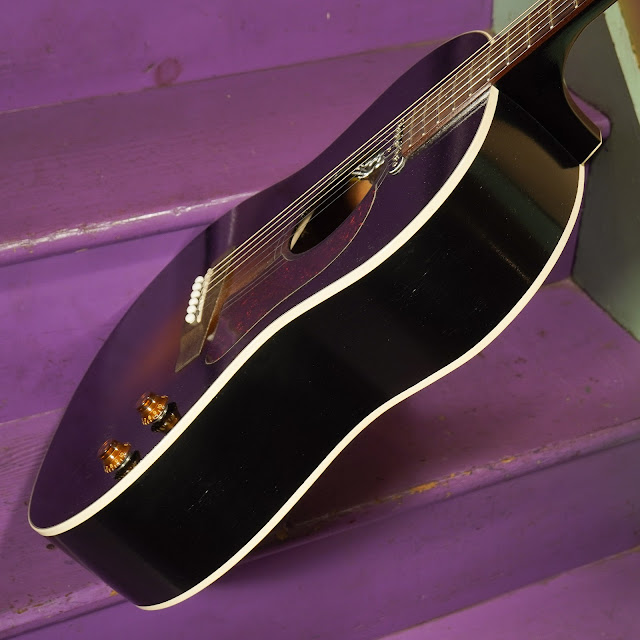2018 Iris OG-E Electrified 00-Size Guitar
Above: acoustic clip
Above: electric clip
This is an early Iris guitar with serial number 010. It was brought to the NAMM show that year to show it off as the owner recalls.
The OG model is the Iris (these are built in Burlington, Vermont) take on the venerable Gibson LG-2 -- a 00-size, vaguely classical-looking body shape, x-braced, steel-strung guitar with a shorter scale length. In this case that scale rises from a classic 24 5/8" or 24 3/4" to 25" -- the PRS standard -- and so it has just a hair more snap in the strings than your average Gibson of similar build.
This OG-E model is a take on the Gibson CF-100E model of the '50s -- an acoustic LG-2-like model but fit with a P90 pickup with its poles exposed at the end of the fretboard. This is similar to how the "Beatle" J-160E model was built, too. This makes it less an "acoustic/electric" (which implies that you're probably using a piezo/acoustic pickup to replicate an acoustic sound of an instrument over your amplifier) and more of an electrified acoustic (which suggests you're using a magnetic/electric guitar pickup on an acoustic which yields a jazzbox/hollowbody electric guitar sort-of voice plugged-in).
It's an odd mix because when you're "acoustic" this is very much an acoustic, standard flattop guitar (albeit an excellent-sounding one). When you're plugged-in it responds more or less like a Gibson ES-125 -- a hollowbody electric guitar with a P90 in it. The pin bridge setup gives it a different feel and vibe, but when I hear that sound it makes me want to play it like an old-school jazzbox.
So -- who is this for? Well, if you like the "soundhole magnetic" vibe of vintage flattops fit with magnetic pickups, it's pretty ideal. It will go bluesy in a heartbeat. Who else is it for, though?
Well -- for me, I really like a guitar like this for sitting-in on mostly-acoustic jams with friends or at (quieter) band practice. If you set yourself up with a small amp and either a volume pedal, on/off pedal, A/B pedal, or the like, you can strum along and sing and whatnot acoustically and then when it comes time for you to take a lead or fills role, you can "pop on" your signal to your amp and get an electric voice. You could also just use the volume knob on the guitar to do that, too, but I'm usually too slow to do that nicely. Others will find it more than enough, however...!
About the guitar itself, though? Iris stuff is made well, plays beautifully when properly setup, and sounds very, very good. This guitar in particular is very friendly to my hand and, at the moment, might have my favorite "feel" of the acoustics in the shop. I'm partial to "the old Gibson thing," though, so that might not be surprising.
My guy Ancel did the glorified setup work on this and it's playing spot-on and ready to go.
Repairs included: a fret level/dress, restring, and setup.
Weight: 4 lbs 3 oz
Scale length: 25"
Nut width: 1 11/16"
Neck shape: medium C
Board radius: 10"
Body width: 14 3/8"
Body depth: 4"
Top wood: solid spruce
Back & sides wood: solid mahogany
Bracing type: x
Bridge: rosewood
Fretboard: rosewood
Neck wood: mahogany
Action height at 12th fret: 3/32” bass 1/16” treble (fast, spot-on)
String gauges: 54w-12 lights (John Pearse nickel-wound set)
Truss rod: adjustable
Neck relief: straight
Fret style: medium
Condition notes: it has some pickwear/usewear on the top at the pickguard and near it and around the body edges but it's not much to write home about -- it's pretty clean throughout. The finish has "open pore" looks, however -- the grain is visible. I like the look but it's worth mentioning.
It comes with: a nice foam-style case.
Consignor tag: CD





















Comments